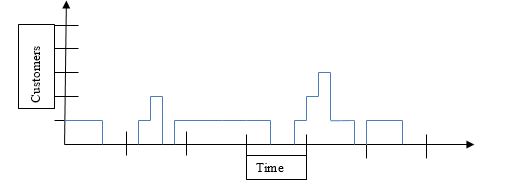Introduction
The current paper attempts to analyze a customer service queuing system of a local gas-filling station according to the following imagined scenario. It operates 24 hours a day, and at night hours, three of its four fuel dispensers are not active for maintenance purposes. Historical evidence reveals that between 2 a.m. and 3 a.m., ten cars arrive on average. Typically, it takes five minutes for a driver to refill their vehicles, but the exact time depends on their behavior and the volume of their fuel tanks. Thus, the time and the fueling duration are variable, and Table 1 below presents this data. In addition to that, Figure 1 visualizes the presence of drivers at the station. This visual reveals that there are two cases (in the 20s and 40s minutes) when customers wait for the service.
Queuing Data and Analysis
Table 1 – Queuing Data.

This information demonstrates that the selected company deals with a peculiar queuing system: Demand and Service Rates Are Variable with One Server. Here, the following is true: The average interarrival time (a) is six minutes (60/10), while the average processing time (p) is five minutes (60/(6+4+2+8+4+4+6+4+6+6)). Cachon and Terwiesch (2023) stipulate that it is possible to calculate the utilization of the queuing system: Utilization = p/a = 5/6 = 0.83. This answer reveals that the fuel dispenser is busy for 83% of the selected hour, which denotes that the company effectively meets its demand.
Summary
The data analysis above has evidently indicated that the selected organization relies on the queuing strategy that consists of one server and deals with variable rates of demand and service. One should acknowledge that this type is found during the selected timeframe, which denotes that multiple servers are used throughout the rest of the day. Now, it is reasonable to show that the selected system implies some advantages and disadvantages that deserve attention.
On the one hand, the queuing type offers multiple benefits for organizations and individuals. First, the utilized system is simple, which denotes that employers do not need extensive resources and efforts to manage or implement them. Second, this approach impresses with cost efficiency because one server is employed to meet the existing demand (Afolalu et al., 2021). In the presented scenario, the utilization rate of 83% denotes that the server is only idle 17% of its time.
Third, the given system relies on and is characterized by increased predictability. Historical trends are used to predict future demand, and the following staffing and queuing decisions are based on this data. If nothing extraordinary happens, this system works effectively and without any errors.
On the other hand, managers should be aware of the potential disadvantages of the queuing type under consideration. The leading issue refers to the fact that the approach becomes useless if the demand unexpectedly rises. In this case, congestion is likely to occur, which will increase customers’ wait time and decrease their satisfaction with service (Cachon & Terwiesch, 2023).
Furthermore, this type is subject to problems because it lacks solid ground. This statement relates to the fact that the effectiveness of the entire system depends on a single server. If something bad happens to this stakeholder, the entire approach stumbles and leads to the negative consequences mentioned above. That is why no one can mention that the selected queuing mode is free from issues.
Conclusion
In conclusion, the presented discussion has demonstrated that the queuing strategy of the gas-filling station has both positive and negative aspects. This discovery is adequate because it is impossible to find ideal processes and solutions. However, the identified pros outweigh the potential cons since this finding clearly proves that the approach implying one server and variable demand and service rates can be perfectly used under certain conditions. The leading requirement is that the average interarrival time should exceed the average processing time. This fact will result in an adequate utilization rate, which means that the server will be able to serve all the arriving customers.
References
Afolalu, S. A., Ikumapayi, O. M., Abdulkareem, A., Emetere, M. E., & Adejumo, O. (2021). A short review on queuing theory as a deterministic tool in sustainable telecommunication system. Materials Today: Proceedings, 44, 2884-2888. Web.
Cachon, G., & Terwiesch, C. (2023). Operations management (3rd ed.). McGraw-Hill.